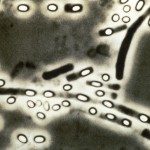Link to Pubmed [PMID] – 17542645
PLoS Pathog. 2007 Jun;3(6):e76
Bacillus anthracis causes three forms of anthrax: inhalational, gastrointestinal, and cutaneous. Anthrax is characterized by both toxemia, which is caused by secretion of immunomodulating toxins (lethal toxin and edema toxin), and septicemia, which is associated with bacterial encapsulation. Here we report that, contrary to the current view of B. anthracis pathogenesis, B. anthracis spores germinate and establish infections at the initial site of inoculation in both inhalational and cutaneous infections without needing to be transported to draining lymph nodes, and that inhaled spores establish initial infection in nasal-associated lymphoid tissues. Furthermore, we found that Peyer’s patches in the mouse intestine are the primary site of bacterial growth after intragastric inoculation, thus establishing an animal model of gastrointestinal anthrax. All routes of infection progressed to the draining lymph nodes, spleen, lungs, and ultimately the blood. These discoveries were made possible through the development of a novel dynamic mouse model of B. anthracis infection using bioluminescent non-toxinogenic capsulated bacteria that can be visualized within the mouse in real-time, and demonstrate the value of in vivo imaging in the analysis of B. anthracis infection. Our data imply that previously unrecognized portals of bacterial entry demand more intensive investigation, and will significantly transform the current perception of inhalational, gastrointestinal, and cutaneous B. anthracis pathogenesis.

